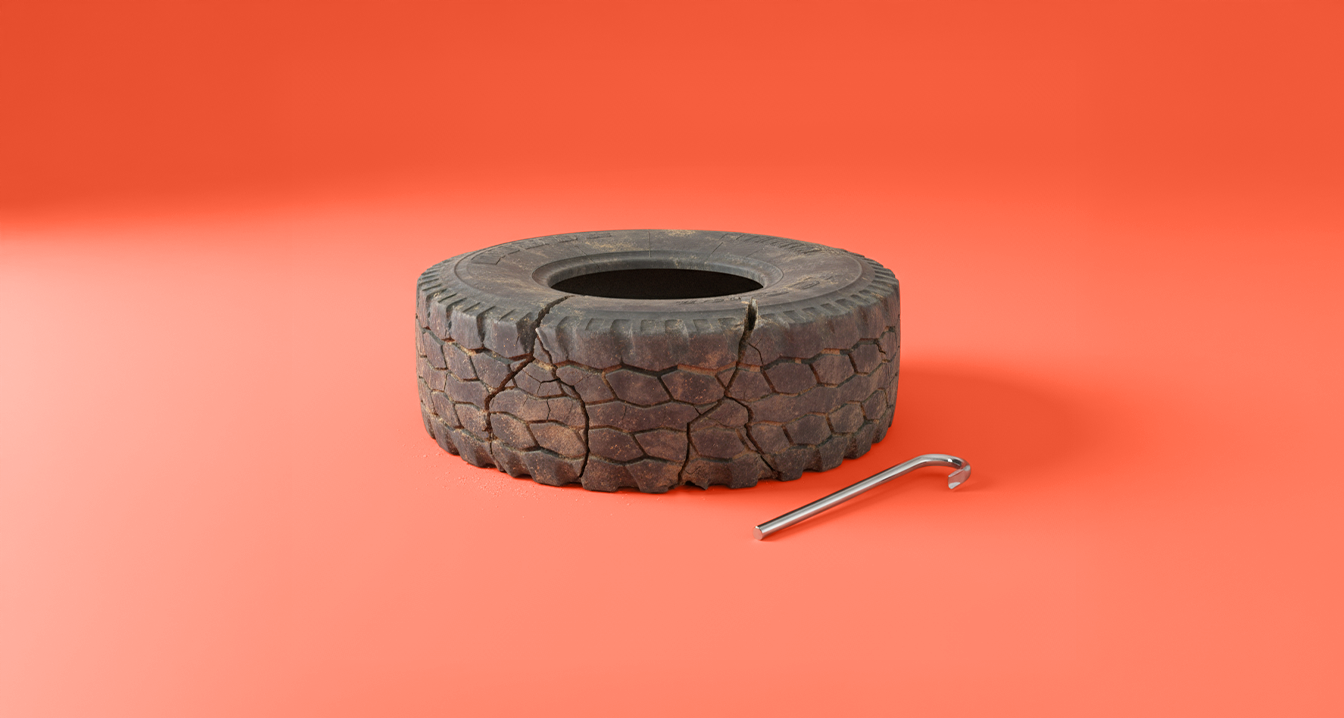Tires are the cornerstone of your truck's performance, because they come into direct contact with the road, bear the weight of the truck and provide it with the required stability and control. Despite their importance, they are exposed to many factors that can lead to damage them faster.
In this article, we'll cover the most common mistakes that lead to faster tire damage, and how you can avoid them to maintain a high level of truck performance for as long as possible.
Whether you are a new or experienced driver or even a truck owner, knowing and avoiding these mistakes will help you extend the life of your tires and thus save money and ensure your safety on the road. So let's get started.
Warning about the increase in the number of traffic accidents related to damaged tires in Saudi Arabia
In its statistics issued by the General Traffic Department, the National Center for Road Safety indicated an increase in the victims of traffic accidents related to tire damage in the first half of 2019. Tire explosion caused 518 victims on roads between cities, an average of 3 victims per day.
Losses due to tire-related road accidents have doubled significantly in the first half of 2019 compared to the same period in the previous year. Deaths have seen a shocking increase of 69%, while injuries have increased by an alarming 28%.
The National Center for Road Safety called for an examination Vehicle tires Ensure its validity, especially in the summer, to avoid accidents resulting from this.
80% of tire problems are caused by easily preventable errors, such as aggressive driving, wrong pressure, and overloading.
The most important wrong practices carried out by drivers and truck owners that lead to rapid tire wear
There are a number of wrong practices carried out by truck drivers, which are among the most important causes of tire wear, which affects the overall performance and safety of the truck. The following is an explanation of these practices:

- Aggressive driving
It is one of the most important causes of uneven tire wear, which leads to a shortening of tire life by up to 25%. This type of driving with its sudden acceleration, severe braking and violent turns is a silent danger that threatens your truck tires.
Imagine that you are accelerating frequently. This means that your truck tires are under tremendous pressure and are subject to heavy friction on the road, resulting in uneven wear on the tire, especially in the front tires, which bear the greatest burden of acceleration. The efficiency of the tire decreases over time and increases the risk of explosion.
Heavy and repeated braking is a fatal blow to your tires. When you brake suddenly, you put a lot of pressure on the tires, which leads to uneven wear of the tire, reducing its ability to grip the road and increasing the risk of skidding, especially in bad weather conditions.
The impact of aggressive driving is not limited to acceleration and braking, but also includes violent cornering. When you turn quickly and suddenly, you expose tire edges to great pressure. These edges are the ones that connect the tire to the wheel and are more susceptible to damage and premature wear due to repeated stress.
- Driving too fast
Driving too fast puts your truck tires under extreme pressure and significantly increases the risk of damage. When you travel at a high speed, the friction of tires on the road increases significantly, generating high heat that causes rapid wear in the tire tread, which is the rubber part that touches the road. In addition, high speed is one of the most important causes of tire explosion, especially if the tires are old or damaged. It also makes the truck less stable and difficult to control, which increases the risk of accidents, so it is necessary to stick to the specified speed and drive carefully to keep you and your truck tires safe.
- Inappropriate pressure
Improper tire pressure, whether low or high, is one of the main factors that lead to tire damage and reduced life.
When the tire pressure is low, the contact area of the tire with the road increases, leading to uneven and rapid wear, especially on the sides of the tire. Low-pressure tires also lose their good grip on the road, increasing the risk of skidding and difficulty in controlling the car, in addition to increasing fuel consumption.
When tire pressure is high, the area of tire contact with the road decreases, leading to rapid wear in the middle of the tire. High-pressure tires make driving more rough and uncomfortable, and increase the risk of tire explosion, especially in high temperatures or when driving on rough roads. Therefore, maintaining appropriate tire pressure in accordance with the recommendations of the car manufacturer is essential to ensure driving safety and extend the life of tires.
- Overload and tires
Overloading poses a great risk to your truck tires, as it significantly increases the pressure on the tires. They wear out quickly and unevenly, reducing their lifespan and increasing the risk of explosion.
Overloading also affects the ability of tires to grip the road, increasing the risk of skidding and difficulty controlling the truck, especially in bad weather conditions. Overloading also increases fuel consumption and affects the performance of the truck's suspension system.
- Neglect in regular maintenance
Regular maintenance of tires includes checking air pressure, rotating tires and checking stability. Neglecting these procedures causes a gradual deterioration in the condition of tires and reducing their life span.
Quiet driving, regular pressure checks, and suspension maintenance are the 3 most important factors for extending the life of a tire.
Practical tips to avoid these mistakes, extend tire life and improve truck performance
To maximize the life of your tires and improve their performance, you can follow five basic driving habits that can make a big difference:
- Adopt a driving style that relies on gentle handling of the accelerator pedal and brakes to save fuel and reduce uneven tire wear.
- Alternating between moderate speeds means changing the car's speed periodically while driving, within the moderate speed range, in order to distribute friction on the tire surface evenly, prevent excessive wear in certain areas, maintain the correct alignment of tires, and extend their life.
- Monitor tire pressure regularly and maintain it properly to ensure perfect contact with the road, prevent uneven wear and enhance truck stability.
- Stick to a tire rotation schedule to promote even wear on all tires.
- Store tires in a cool, dry and dark place, avoid exposure to direct sunlight or heat sources. Make sure they are clean before storing them and remove any dirt or oil stuck in them. It is also preferable to store tires in special bags or covers to protect them from dust and moisture.
Also, don't forget that choosing the right tires for your truck and driving conditions has a significant impact on extending tire life, so you should refer to your truck manual or consult an expert mechanic to determine the right tire size, as well as the recommended load index and speed rating for the truck.
Also consider the prevailing weather conditions in your area. You may need all-season tires or specialized tires designed specifically for those conditions.
Don't overlook the importance of Regular maintenance For the truck as a whole, a truck that is regularly serviced — including a proper suspension system, effective brakes and properly aligned wheels — significantly reduces stress on tires, which in turn leads to balanced tire wear, extending its lifespan.
Therefore, make regular scheduled checks an essential part of your truck maintenance routine, including checking alignment and balancing, to maximize the life of your tires. Regular maintenance is not only to keep your truck in good condition in general, but is a direct investment in extending tire life and saving costs in the long term.
Practical examples of common problems and their proven solutions
Now, let's give you some practical examples of the most common problems that your truck tires may face, with appropriate solutions:
The problem of tire puncture
It occurs when any sharp object penetrates the tire and causes air pressure to leak in the tires. You can identify this problem by:
- Hearing a beep coming from one of the tires.
- The feeling that the truck is being pulled to one side.
- The tire pressure warning light appears on the dashboard “if your truck is equipped with it”.
- There is a clear drop in tire pressure or the tire has become completely flat.
There are many causes that lead to this common problem, the most prominent of which is driving on roads that are full of debris or sharp objects that may penetrate the tire. The wear of the tire tire significantly makes it more susceptible to punctures and tears, increasing the likelihood of air loss and causing a flat tire.
Proven solutions to the problem of tire punctures
The available solutions vary depending on the situation and the extent of tire damage. The fastest and most common solution is to replace the flat tire with the spare tire in the truck, while following the basic steps that include securing the car, using the jack and the wrench to remove and install the tires safely.
Small and temporary punctures can be dealt with using a tire repair kit, which relies on injecting a sealant, noting that this procedure is often temporary and requires a subsequent examination by a specialist.
While permanent solutions for small holes in the tire tire are the tire patch that is placed on the inside, or the tire plug inserted from the outside, but the application of these solutions is preferred by a professional tire technician to ensure safe and effective repair.
Remember that not all holes are repairable. If the hole is large, in the sidewall, or the tire is significantly damaged, replacing the entire tire is the best option to ensure safety.
Uneven tire wear
It is a common problem that indicates that part of the tire wears out faster than other parts. It is divided into several main types:
- Corrosion on the outer edges:
It is often caused by low tire pressure or aggressive driving in corners. The solution is to adjust the tire pressure regularly and avoid aggressive cornering driving.
- Corrosion in the center:
It is due to increased tire pressure, so you should adjust the tire pressure according to the recommendations and avoid exceeding the recommended limit.
- Erosion in the form of cups or patches:
This type indicates suspension problems or wheel imbalance. The solution is to check and repair the suspension system and balance the wheels periodically.
- One-sided corrosion:
It results from wheel misalignment, so wheel alignment should be performed by a specialist technician.
From wheezing to steering wheel vibration... every symptom has an explanation, and most tire problems are solvable if diagnosed early.
Wheel vibrations and imbalance
It is a problem caused by the uneven distribution of weight around the wheel circumference, which causes the truck to vibrate while driving. Symptoms are clearly visible in the form of noticeable vibration in the steering wheel, seats, or truck floor, especially at certain speeds. This may be accompanied by uneven tire wear, often in the form of wear in the form of cups or patches.
The best and proven solution to this problem is wheel alignment. A specialized tire technician uses a wheel alignment device to add accurate balancing weights in the appropriate positions on the wheel in order to restore an even distribution of weight, eliminate annoying vibrations and improve the driving experience.
There are a range of other common problems that cause tire damage. You can identify them and their proven solutions and consult specialists in the field as soon as you contact”Your path“The leading tire manufacturer in Saudi Arabia and the Middle East.
.jpg)






